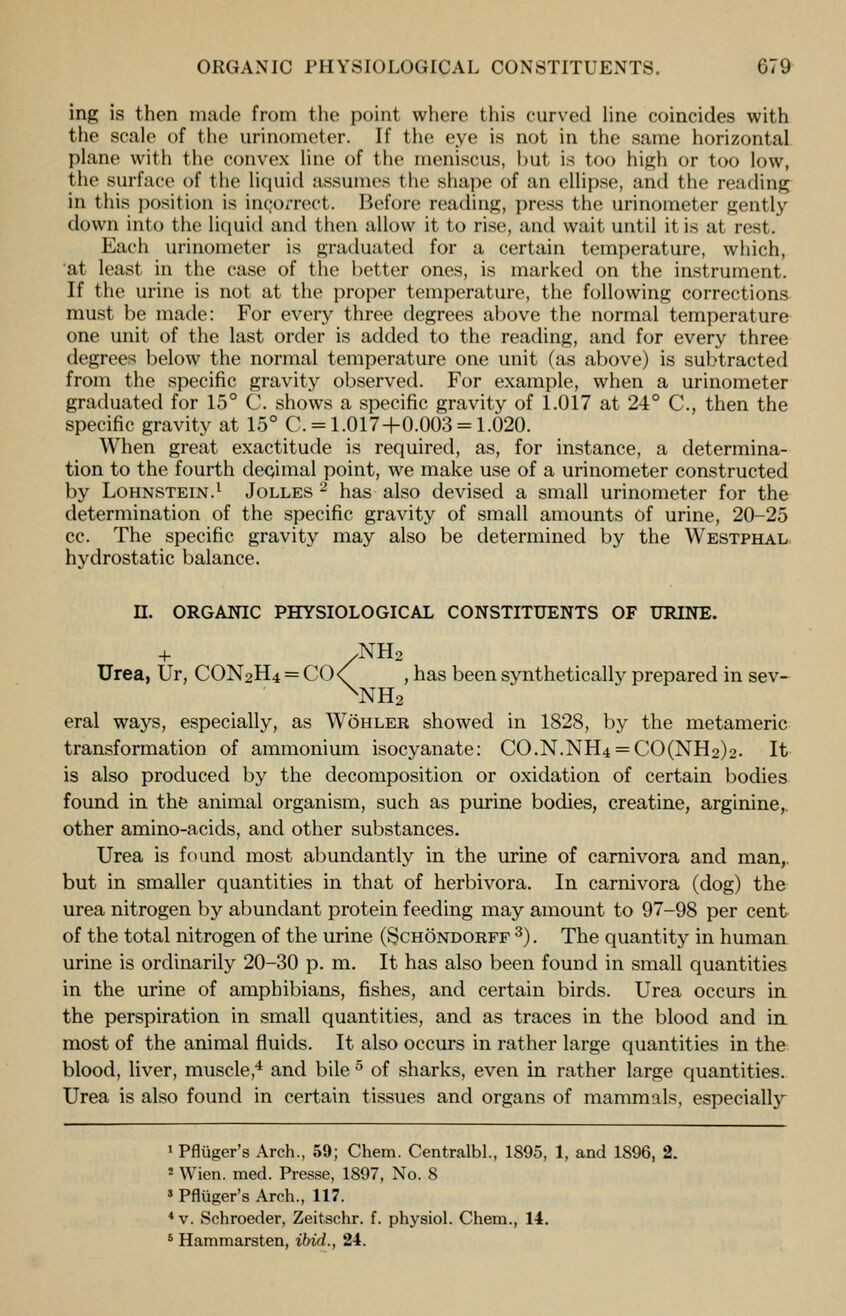
Full resolution (JPEG) - On this page / på denna sida - XIV. Urine - I. Physical Properties of Urine - II. Organic Physiological Constituents of Urine

<< prev. page << föreg. sida << >> nästa sida >> next page >>
Below is the raw OCR text
from the above scanned image.
Do you see an error? Proofread the page now!
Här nedan syns maskintolkade texten från faksimilbilden ovan.
Ser du något fel? Korrekturläs sidan nu!
This page has never been proofread. / Denna sida har aldrig korrekturlästs.
ORGANIC PHYSIOLOGICAL CONSTITUENTS. 679
ing is then made from the point where this curved line coincides with
the scale of the urinometer. If the eye is not in the same horizontal
plane with the convex line of the meniscus, hut is too high or too low,
the surface of the liquid assumes the shape of an ellipse, and the reading
in this position is incorrect. Before reading, press the urinometer gently
down into the liquid and then allow it to rise, and wait until it is at rest.
Each urinometer is graduated for a certain temperature, which,
at least in the case of the better ones, is marked on the instrument.
If the urine is not at the proper temperature, the following corrections
must be made: For every three degrees above the normal temperature
one unit of the last order is added to the reading, and for every three
degrees below the normal temperature one unit (as above) is subtracted
from the specific gravity observed. For example, when a urinometer
graduated for 15° C. shows a specific gravity of 1.017 at 24° C, then the
specific gravity at 15° C. = 1.017+0.003 = 1.020.
When great exactitude is required, as, for instance, a determina-
tion to the fourth decimal point, we make use of a urinometer constructed
by Lohnstein. 1
Jolles 2
has also devised a small urinometer for the
determination of the specific gravity of small amounts of urine, 20-25
cc. The specific gravity may also be determined by the Westphal
hydrostatic balance.
II. ORGANIC PHYSIOLOGICAL CONSTITUENTS OF URINE.
+ /NH2
Urea, Ur, CON2H4 = CO^ , has been synthetically prepared in sev-
NNH2
eral ways, especially, as Wohler showed in 1828, by the metameric
transformation of ammonium isocyanate: CO.N.NH4 = CO(NH2)2- It
is also produced by the decomposition or oxidation of certain bodies
found in the animal organism, such as purine bodies, creatine, arginine,
other amino-acids, and other substances.
Urea is found most abundantly in the urine of carnivora and man,,
but in smaller quantities in that of herbivora. In carnivora (dog) the
urea nitrogen by abundant protein feeding may amount to 97-98 per cent
of the total nitrogen of the urine (Schondorff 3
) . The quantity in human
urine is ordinarily 20-30 p. m. It has also been found in small quantities
in the urine of amphibians, fishes, and certain birds. Urea occurs in
the perspiration in small quantities, and as traces in the blood and in
most of the animal fluids. It also occurs in rather large quantities in the
blood, liver, muscle,4
and bile 5 of sharks, even in rather large quantities.
Urea is also found in certain tissues and organs of mammals, especially
1
Pfliiger’s Arch., 59; Chem. Centralbl., 1895, 1, and 1896, 2.
!
Wien. med. Presse, 1897, No. 8
s
Pfluger’s Arch., 117.
4
v. Schroeder, Zeitschr. f. physiol. Chem., 14.
6
Hammarsten, ibid., 24.
<< prev. page << föreg. sida << >> nästa sida >> next page >>